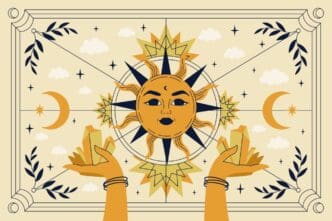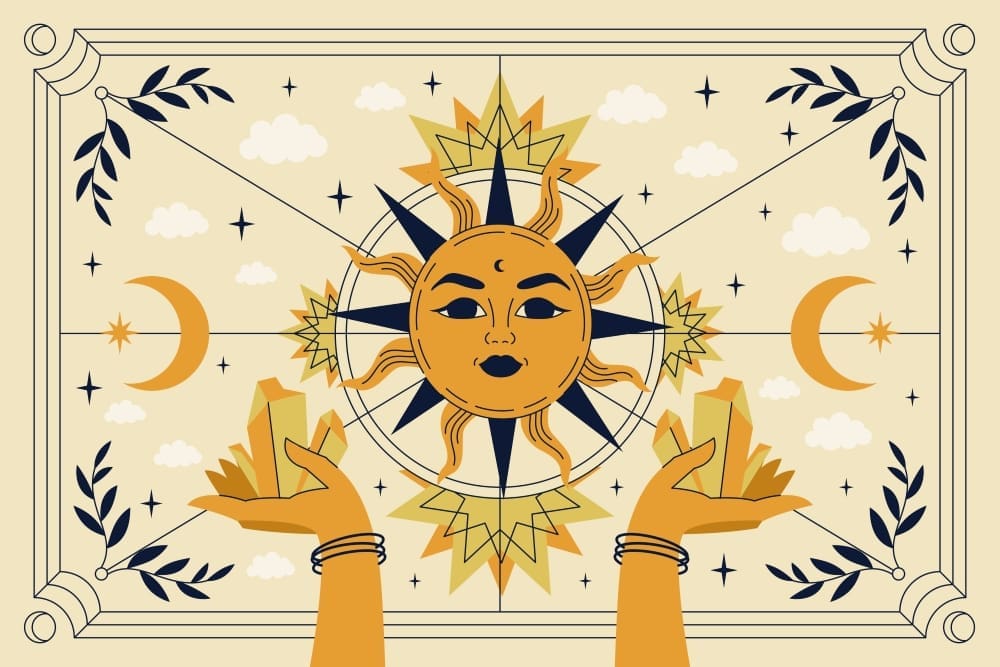Your Vedic Sun Sign, or Surya Rashi, reveals the core essence of your soul’s journey in this lifetime, determined by the Sun’s placement in the zodiac at your exact moment of birth. Unlike the more familiar Western Sun Sign, the Vedic system uses the Sidereal zodiac, which is aligned with the fixed constellations as they currently appear in the sky. This astronomical accuracy means your Vedic Sun Sign is often different—typically one sign back—from your Western one, offering a profound and often more resonant explanation of your inner self, your life’s purpose, your vitality, and the source of your truest authority.
The Great Cosmic Divide: Sidereal vs. Tropical Zodiacs
To understand your Vedic Sun Sign, you must first grasp the fundamental difference between the two primary zodiacal systems used in astrology today. The divergence between them is the single biggest reason your sign likely changes when you look at your Vedic chart.
The Western astrological system uses the Tropical Zodiac. This system is tied to the Earth’s seasons. It marks the beginning of the zodiac, zero degrees of Aries, at the exact moment of the Spring Equinox in the Northern Hemisphere.
This system was astronomically accurate thousands of years ago. However, due to a phenomenon called the precession of the equinoxes—a slow, 26,000-year wobble in the Earth’s axis—the constellations have drifted from their original alignment with the seasons.
Vedic astrology, or Jyotish, uses the Sidereal Zodiac. This system is fixed to the stars themselves. It accounts for the precession of the equinoxes by aligning its zodiac with the actual current positions of the constellations in the sky.
The gap between the Tropical and Sidereal zodiacs is known as the Ayanamsha. As of today, this difference is approximately 24 degrees. This cosmic drift is why your Sun, which might be at 25 degrees of Aries in a Western chart, is actually at 1 degree of Aries in a Vedic chart, placing it in the previous sign of Pisces.
What Your Vedic Sun Sign (Surya Rashi) Truly Represents
In Vedic astrology, the Sun, known as Surya, is the king of the planetary cabinet. It represents the Atma, which translates to the soul or the divine spark within you. It is the celestial body that governs your core identity, ego, and life force (prana).
Your Vedic Sun Sign speaks to your soul’s purpose. It indicates the area of life and the qualities you are meant to develop to express your most authentic, authoritative self. It is less about your surface-level personality and more about your fundamental character and constitution.
Surya also represents the father, authority figures, government, and your capacity for leadership. The strength and placement of the Sun in your chart reveal your confidence, vitality, and ability to shine your light in the world. A well-placed Sun can bestow ambition and recognition, while a challenged Sun may indicate struggles with self-esteem or authority.
This contrasts with the modern Western interpretation, where the Sun sign is often seen as the primary descriptor of one’s personality traits. In Jyotish, your outward personality is more clearly seen through the Ascendant (Lagna), while your mind and emotions are the domain of the Moon (Chandra).
How to Accurately Find Your Vedic Sun Sign
Discovering your true Vedic Sun Sign is a precise process that requires more than just knowing your birthday. Because the Sun changes signs on different dates each year, a generic list is only an approximation. For 100% accuracy, you must generate a birth chart.
Step 1: Gather Your Birth Data
You will need your exact birth details: your full date of birth (day, month, year), your precise time of birth (as close to the minute as possible), and your city and country of birth. An incorrect birth time can, in some cases, alter the sign.
Step 2: Use a Vedic Astrology Calculator
The easiest and most reliable method is to use a free Vedic astrology software or website. Input your birth data into the calculator. Ensure the settings are correct, specifically that the “Ayanamsha” is set (Lahiri is the most common and government-approved Ayanamsha in India).
Step 3: Locate the Sun in Your Chart
Once your chart is generated, you need to find the symbol for the Sun. It is typically abbreviated as “Su” or “Sy.” The chart will show which of the twelve houses and which sign this planet is located in.
Step 4: Identify the Sign
The sign (Rashi) in which the Sun is placed is your Vedic Sun Sign (Surya Rashi). For reference, here are the approximate date ranges for each sign. Remember, these can shift by a day, so a calculated chart is essential for accuracy.
- Mesha (Aries): April 14 – May 14
- Vrishabha (Taurus): May 15 – June 14
- Mithuna (Gemini): June 15 – July 16
- Karka (Cancer): July 17 – August 16
- Simha (Leo): August 17 – September 16
- Kanya (Virgo): September 17 – October 17
- Tula (Libra): October 18 – November 16
- Vrishchika (Scorpio): November 17 – December 15
- Dhanu (Sagittarius): December 16 – January 14
- Makara (Capricorn): January 15 – February 12
- Kumbha (Aquarius): February 13 – March 14
- Meena (Pisces): March 15 – April 13
A Guide to the 12 Vedic Sun Signs
Once you’ve found your Surya Rashi, you can begin to understand the unique mission of your soul. Here is a brief look at the core energy of the Sun in each sign.
Mesha (Aries)
The soul’s purpose here is to pioneer, lead, and act with courage. Sun in Aries individuals are born to be initiators, driven by a powerful impulse to forge new paths. Their vitality is high, but they must learn to channel their fiery energy constructively and avoid impulsive ego battles.
Vrishabha (Taurus)
Here, the soul seeks to create stability, beauty, and lasting value. Sun in Taurus natives are grounded, patient, and have a deep connection to the material world. Their life force is steady and enduring, and their purpose involves building security and appreciating the sensual pleasures of life.
Mithuna (Gemini)
The soul’s journey is one of communication, learning, and intellectual curiosity. Sun in Gemini individuals are adaptable, witty, and driven to gather and share information. Their core identity is tied to their intellect and their ability to make connections in the world around them.
Karka (Cancer)
The soul’s purpose is to nurture, protect, and connect on an emotional level. Sun in Cancer natives are deeply sensitive, intuitive, and find their strength in caring for family and community. Their identity is linked to their emotional core and their role as a provider of comfort and security.
Simha (Leo)
With the Sun in its own sign, the soul’s purpose is to shine, lead, and express its unique creative power. Sun in Leo individuals are natural leaders, brimming with confidence, charisma, and a dramatic flair. Their life force is powerful, and they are here to take center stage and inspire others.
Kanya (Virgo)
The soul’s mission is one of service, healing, and perfection. Sun in Virgo natives are analytical, practical, and detail-oriented. They find their purpose in fixing what is broken, organizing systems, and dedicating themselves to improving the lives of others, often through health and wellness.
Tula (Libra)
Here, the soul seeks to create harmony, justice, and balanced relationships. Sun in Libra individuals are diplomatic, charming, and have a strong sense of fairness. Their identity is often found through partnership and their ability to mediate and bring beauty and grace into social interactions.
Vrishchika (Scorpio)
The soul’s journey is one of profound transformation, uncovering hidden truths, and wielding power. Sun in Scorpio natives are intense, magnetic, and deeply perceptive. They are here to dive beneath the surface, confront life’s mysteries, and emerge reborn from crisis.
Dhanu (Sagittarius)
The soul’s purpose is to seek truth, wisdom, and higher meaning. Sun in Sagittarius individuals are optimistic, philosophical, and freedom-loving. Their life force is fueled by a quest for knowledge, travel, and aligning with a belief system or a great cause.
Makara (Capricorn)
Here, the soul’s mission is to build enduring structures in the world through discipline, ambition, and hard work. Sun in Capricorn natives are practical, responsible, and driven to achieve public recognition. Their identity is tied to their career and their ability to create a lasting legacy.
Kumbha (Aquarius)
The soul’s journey is one of innovation, humanitarianism, and serving the collective. Sun in Aquarius individuals are forward-thinking, unconventional, and dedicated to social causes. They find their purpose in breaking from tradition and contributing their unique genius to the group.
Meena (Pisces)
The soul’s purpose is to transcend the ego and connect with the universal whole through compassion and spirituality. Sun in Pisces natives are imaginative, empathetic, and deeply intuitive. Their path involves surrender, artistic expression, and finding the divine in all things.
Beyond the Sun: The Three Pillars of Your Vedic Chart
While discovering your Vedic Sun Sign is a crucial first step, it is only one-third of the primary story. Jyotish places equal, if not greater, importance on two other placements: your Ascendant and your Moon sign.
Your Ascendant (Lagna) is the zodiac sign that was rising on the eastern horizon at the moment of your birth. It represents your physical body, your social personality, and the overall path your life will take. It is the lens through which you experience the world and how the world perceives you.
Your Moon Sign (Chandra Rashi) is arguably the most important placement in Vedic astrology. It represents your mind, emotions, subconscious patterns, and inner peace. It governs how you feel and react to life’s events and is the basis for the all-important Dasha system, which outlines the timing of life events.
A true understanding of your Vedic makeup comes from synthesizing the information from these three pillars: the Sun (your soul), the Moon (your mind), and the Ascendant (your body and path). They work together to paint a complete and nuanced portrait of who you are.
Finding your Vedic Sun Sign is like discovering a hidden layer of your identity. It moves beyond surface-level personality to reveal the deeper current of your soul’s intent. By understanding why it’s different from your Western sign and what it represents, you gain a powerful tool for self-awareness, helping you to align more closely with your core purpose and shine your authentic light in the world.








